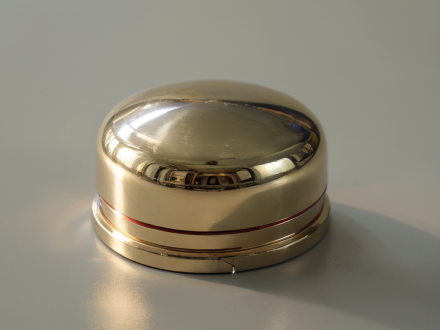Hard Chrome Plating Aluminum and Electroplating Aluminum
Hard chrome plating aluminum and electroplating aluminum are both popular techniques used for enhancing the properties of aluminum parts. These methods offer unique benefits depending on the desired outcome, whether it be increased durability, improved appearance, or better corrosion resistance. Understanding these processes and their differences is crucial when choosing the right coating for your specific needs.
Hard Chrome Plating provides superior hardness and wear resistance, while Electroplating offers a smoother finish and lower cost. But which is more suitable for your project? Let’s explore both options.
Now, let’s dive deeper into the specifics of Hard Chrome Plating and Electroplating Aluminum, and understand their key differences.
What is Hard Chrome Plating Aluminum?
Hard chrome plating aluminum is a process that involves depositing a layer of chromium onto the surface of aluminum through electroplating. During this process, the aluminum component is submerged in a solution containing chromium compounds, and an electrical current is introduced. This triggers the deposition of chromium onto the aluminum, resulting in a thin yet exceptionally resilient coating. This coating offers remarkable hardness, resistance to wear, and protection against corrosion. Hard chrome plating finds extensive application in sectors such as automotive, aerospace, and manufacturing, where durability and performance under high-stress conditions are paramount. It is highly esteemed for its capacity to safeguard aluminum parts against wear and tear in rigorous environments.

Step by Step Process of Hard Chrome Plating Aluminum.
The hard chrome plating process involves several key steps to ensure a durable and high-quality finish. Following are several key steps:
1. Surface Preparation:
The first step in hard chrome plating is thorough surface preparation. The aluminum part must be cleaned to remove oils, dirt, and any other contaminants that might interfere with the plating process. This is typically done through abrasive cleaning methods such as sandblasting or using a chemical solution to etch the surface, ensuring optimal adhesion of the chromium layer.
2. Plating:
Once the aluminum surface is prepared, the part is immersed in an electrolytic bath containing a solution of chromium compounds. An electrical current is passed through the bath, causing chromium ions to be deposited onto the aluminum surface. The plating process can take several hours, depending on the desired thickness of the chrome layer.
3. Curing:
After the plating is complete, the part is carefully removed from the bath and baked in an oven to cure the chromium coating. This step improves the adhesion of the chrome layer to the aluminum and enhances its hardness. Curing also helps to eliminate any residual moisture that may have remained after plating.
4. Inspection:
The final phase consists of a thorough inspection of the plated component to confirm that the chromium layer is uniform, smooth, and adheres appropriately to the aluminum substrate. This evaluation includes checking the coating’s thickness, hardness, and overall quality, along with conducting tests for wear resistance and corrosion resistance. This meticulous examination ensures that the part complies with the specified requirements and is devoid of defects such as pitting, cracking, or inconsistencies in the plating.
What is Electroplating Aluminum?
Electroplating aluminum is a process where a metal coating, typically copper, nickel, or chrome, is applied to the surface of aluminum via an electrochemical reaction. In this process, aluminum is immersed in an electrolyte solution containing metal salts, and an electric current is used to transfer the metal ions onto the aluminum’s surface. Unlike hard chrome plating, electroplating aluminum can be used for aesthetic purposes, such as achieving shiny finishes or altering the appearance of the metal.
Electroplating is commonly used in industries such as electronics, jewelry, and automotive, where both functional and decorative finishes are important. The process is more cost-effective than hard chrome plating but offers lower wear resistance.

Key Differences Between Hard Chrome Plating and Electroplating Aluminum
The differences between hard chrome plating and electroplating aluminum are crucial for choosing the right process based on the intended application. Below is a comparison table that highlights key aspects, from surface hardness to cost considerations.
| Factor | Hard Chrome Plating | Electroplating Aluminum |
|---|---|---|
| Surface Hardness and Wear Resistance | Provides a much harder surface, ideal for high wear resistance in industrial or automotive components. | Less durable, more prone to scratches and wear; suitable for lower-stress applications. |
| Corrosion Resistance | Offers superior corrosion protection, especially in extreme conditions such as high temperatures and aggressive chemicals. | Enhances corrosion resistance but may not be as effective in harsh environments. |
| Cost Comparison | Higher cost due to the complex process and durability of the coating. | More affordable, but offers less performance and longevity. |
| Process Complexity | Requires specialized equipment and skilled operators for a more intricate process. | Simpler process, widely available, and suitable for a broader range of products. |
What are the Advantages and Disadvantages of Hard Chrome Plating Aluminum?
Hard chrome plating on aluminum is a commonly employed technique because of its outstanding performance in challenging environments. Nevertheless, like any procedure, it presents both advantages and disadvantages. The following provides a comprehensive overview of the key benefits and drawbacks to aid in assessing its appropriateness for various applications.

Advantages:
1. Outstanding Hardness
Hard chrome plating significantly enhances the hardness of aluminum surfaces, making them resistant to wear, abrasion, and mechanical stress. This makes it ideal for parts exposed to heavy friction or harsh conditions.
2. Exceptional Wear Resistance
The plated surface is highly durable and offers excellent wear resistance, ensuring the longevity of parts, even when exposed to repeated use or abrasive environments. This is particularly valuable in industries like automotive, aerospace, and manufacturing.
3. Superior Corrosion Protection
The hard chrome layer acts as a protective barrier, significantly improving the aluminum’s resistance to corrosion. This makes it suitable for parts exposed to chemicals, high temperatures, and moisture, providing long-term protection in demanding environments.
4. Long-lasting Performance
Hard chrome plating is known for its durability, with the coating often lasting for many years without significant degradation. Even in extreme conditions, it maintains its protective qualities, reducing the need for frequent replacements.
Disadvantages:
1. Higher Cost
Hard chrome plating is more expensive than electroplating due to the complexity of the process, the need for specialized equipment, and the durability of the coating. This can make it less cost-effective for applications where extreme wear resistance is not required.
2. Environmental Impact
The process involves the use of chromium compounds, which can pose environmental and health risks if not handled properly. Proper waste disposal and safety measures are essential to mitigate the environmental impact of these chemicals.
3. Thick Coating Issues
In certain applications, the hard chrome layer may be excessively thick, potentially disrupting the part’s fit or function. In these instances, further post-plating processing—such as polishing or grinding—might be necessary to attain the required dimensions.
What are the Advantages and Disadvantages of Electroplating Aluminum?
Electroplating aluminum is a popular method for improving the appearance and performance of aluminum parts. It offers several benefits, particularly in cost-effectiveness and versatility. However, there are also limitations when it comes to durability and performance in demanding environments. Below is a breakdown of the key advantages and disadvantages of electroplating aluminum.
Advantages:
1. Cost-Effective
Electroplating aluminum is a more affordable option compared to hard chrome plating. The process is simpler, requires less specialized equipment, and uses fewer resources, making it a cost-effective choice for manufacturers working within a budget.
2. Variety of Finishes
Electroplating offers a range of finish options, including shiny, matte, and colored coatings, providing aesthetic flexibility for a wide variety of applications. This makes it ideal for consumer goods, decorative finishes, and other applications where appearance is a key factor.
3. Environmentally Friendly
Compared to hard chrome plating, electroplating tends to be more environmentally friendly. It uses fewer harmful chemicals, and the process typically generates less waste, making it a more sustainable option in some industries.
Disadvantages:
1. Lower Durability
One of the primary disadvantages of electroplating aluminum is that it does not provide the same level of durability as hard chrome plating. The electroplated layer is thinner, making it more susceptible to damage in high-stress, abrasive, or harsh environments.
2.Reduced Wear Resistance
The thinner coating from electroplating also results in lower wear resistance. This makes electroplated aluminum unsuitable for applications where the parts are exposed to significant friction, heavy loads, or demanding operational conditions.
What Color is Aluminum Electroplating?
The color of electroplated aluminum can vary depending on the type of metal used in the plating process. For example, when nickel is electroplated onto aluminum, it can produce a silvery finish, while copper plating creates a reddish-brown hue. Gold plating is also a popular option for decorative purposes, providing a rich golden finish. Additionally, anodizing treatments can be used in conjunction with electroplating to achieve a range of colors.

Which Should You Choose for Your Project: Hard Chrome Plating or Electroplating?
When choosing between hard chrome plating and electroplating for aluminum, it’s essential to weigh the specific requirements of your project against the characteristics and advantages of each option. Here are several factors to consider:
1. Durability and Wear Resistance
- Hard Chrome Plating: Offers superior durability and wear resistance, making it ideal for components subjected to friction, abrasion, or harsh environments. It’s perfect for applications like automotive parts, industrial machinery, and tools that require significant longevity.
- Electroplating: Provides a thinner layer of metal that is not as durable under heavy wear conditions. It’s more suitable for decorative applications or components with lighter loads.
2. Cost Considerations
- Hard Chrome Plating: Generally more expensive due to the complexity of the process and the cost of materials. However, this investment can be justified for high-performance applications due to the long-term savings from reduced maintenance and longer lifespan.
- Electroplating: More cost-effective and offers a variety of finishes, making it a good choice for projects where budget constraints are a priority, or where the performance demands are lower.
3. Appearance
- Hard Chrome Plating: Typically results in a dull finish, though it can be polished to achieve a reflective surface. It may not provide the aesthetic appeal desired for certain products.
- Electroplating: Available in a wide range of finishes and colors, making it ideal for decorative applications. It can enhance the aesthetic of consumer products, such as jewelry and automotive trim.
4. Environmental Impact
- Hard Chrome Plating: The process can involve hazardous chemicals and requires careful handling and disposal, as well as air quality control measures.
- Electroplating: While also involving chemicals, advancements in technology have led to more environmentally friendly options in this area. However, it’s still crucial to assess the specific processes used.
Start Your Parts CNC Machining and Plating Project
Start your CNC machining and electroplating project, VMT is your ideal choice. We are a professional CNC machining company, not only good at making CNC parts, but also providing multiple services including surface treatment.
We know that without appropriate surface treatment, the high quality of aluminum parts cannot be mentioned. Therefore, we provide high -quality electroplating services without looking for electroplating suppliers. We are committed to providing the most suitable electroplating solution for your aluminum parts.
Frequently Asked Questions
Is Chrome Plating the Same as Electroplating?
Chrome plating and electroplating are related but not exactly the same. Electroplating is a process in which a thin layer of metal is deposited onto a surface through an electric current. Chrome plating is a specific type of electroplating where chromium is the metal being deposited. While all chrome plating is a form of electroplating, not all electroplating involves chrome. Electroplating can be done with various metals such as gold, silver, nickel, copper, and others, each serving different purposes such as enhancing appearance, reducing wear, or preventing corrosion.
Can Aluminum be Hard Chrome Plated?
Yes, aluminum can be hard chrome plated, but it requires a special pre-treatment process because aluminum is a non-ferrous metal with a high oxidation rate. Hard chrome plating on aluminum is often used to improve wear resistance, reduce friction, and increase hardness. However, before applying the chrome coating, the aluminum surface must be thoroughly cleaned and sometimes treated with a conversion coating or an etching process to ensure proper adhesion of the chrome. Hard chrome plating on aluminum is commonly used in industries like aerospace, automotive, and manufacturing.
Can We do Electroplating on Aluminum?
Yes, aluminum can be electroplated, but it’s a more challenging process compared to plating on other metals. Aluminum has an oxide layer that can hinder the adhesion of the plating material. To successfully electroplate aluminum, the oxide layer must be removed, often by etching or using an acid bath. Additionally, a conductive base layer, like nickel or copper, is typically applied first to improve the adhesion of the plating. Once the base layer is applied, the aluminum can be electroplated with other metals like gold, silver, or nickel, depending on the desired properties.
What is the Best Plating for Aluminum?
The best plating for aluminum depends on the desired properties of the finished product. Common choices include:
Anodizing: This is one of the most popular and effective finishes for aluminum. It creates a durable, corrosion-resistant surface that is also aesthetically pleasing with various color options.
Nickel Plating: Often used for its corrosion resistance and smooth finish, nickel plating can be a good choice for aluminum when enhanced durability is needed.
Chrome Plating: For both decorative and hard chrome applications, it provides a high-shine finish and improves hardness and wear resistance.
Zinc Plating: While primarily used for corrosion protection, it may not offer the same level of durability as anodizing or nickel plating, but it is cost-effective for certain applications.



